Surface Hardening of Zr-1.0Sn-1.0Nb-0.3Fe Alloy Induced by Laser Surface Remelting
Abstract
1. Introduction
2. Experimental Procedures
2.1. Materials
2.2. Laser Surface Treatment
2.3. Microstructural Characterization
2.4. Hardness Testing
3. Results and Discussion
3.1. Phase Constitution
3.2. Texture
3.3. Microstructure
3.4. Microhardness
4. Conclusions
- (1)
- After the LSR treatment, two distinct microstructural regions are formed on the surface of the Zr-1.0Sn-1.0Nb-0.3Fe zirconium alloy: (i) the RZ—consisting of fine α lath structures and precipitates distributed along the lath boundaries—and (ii) the HAZ—composed of blocky α grains, α laths, and precipitates.
- (2)
- The initial sample exhibits a typical bimodal basal texture, while the LSR-treated sample surface shows a random texture. This change can be attributed to the selection suppression of α variants during laser-induced rapid cooling.
- (3)
- Following the LSR treatment, the average hardness of the RZ rises to 285.7 ± 8.3 HV, ~40% higher than the substrate. This enhancement is primarily ascribed to the effective grain refinement induced by LSR.
Author Contributions
Funding
Institutional Review Board Statement
Informed Consent Statement
Data Availability Statement
Conflicts of Interest
References
- D’Auria, F.; Debrecin, N.; Glaeser, H. Strengthening nuclear reactor safety and analysis. Nucl. Eng. Des. 2017, 324, 209–219. [Google Scholar] [CrossRef]
- Gu, Z. History review of nuclear reactor safety. Ann. Nucl. Energy 2018, 120, 682–690. [Google Scholar] [CrossRef]
- Lewis, E.E.; Lewis, H.W. Nuclear Power Reactor Safety. Phys. Today 1979, 32, 52–54. [Google Scholar] [CrossRef]
- Yun, D.; Lu, C.; Zhou, Z.; Wu, Y.; Liu, W.; Guo, S.; Shi, T.; Stubbins, J.F. Current state and prospect on the development of advanced nuclear fuel system materials: A review. Mater. Rep. Energy 2021, 1, 100007. [Google Scholar] [CrossRef]
- Duan, Z.; Yang, H.; Satoh, Y.; Murakami, K.; Kano, S.; Zhao, Z.; Shen, J.; Abe, H. Current status of materials development of nuclear fuel cladding tubes for light water reactors. Nucl. Eng. Des. 2017, 316, 131–150. [Google Scholar] [CrossRef]
- Tang, C.; Stueber, M.; Seifert, H.J.; Steinbrueck, M. Protective coatings on zirconium-based alloys as accident-tolerant fuel (ATF) claddings. Corros. Rev. 2017, 35, 141–165. [Google Scholar] [CrossRef]
- Yan, Y.; Burtseva, T.A.; Billone, M.C. High-temperature steam-oxidation behavior of Zr-1Nb cladding alloy E110. J. Nucl. Mater. 2009, 393, 433–448. [Google Scholar] [CrossRef]
- Jung, Y.-I.; Kim, H.-G.; Kim, I.-H.; Kim, S.-H.; Park, J.-H.; Park, D.-J.; Yang, J.-H.; Koo, Y.-H. Strengthening of Zircaloy-4 using Y2O3 particles by a laser-beam-induced surface treatment process. Mater. Des. 2017, 116, 325–330. [Google Scholar] [CrossRef]
- Wang, Y.; Zhou, W.; Wen, Q.; Ruan, X.; Luo, F.; Bai, G.; Qing, Y.; Zhu, D.; Huang, Z.; Zhang, Y.; et al. Behavior of plasma sprayed Cr coatings and FeCrAl coatings on Zr fuel cladding under loss-of-coolant accident conditions. Surf. Coat. Technol. 2018, 344, 141–148. [Google Scholar] [CrossRef]
- Kim, H.G.; Kim, I.H.; Jung, Y.I.; Park, D.J.; Park, J.H.; Choi, B.K.; Lee, Y.H. Out-of-pile performance of surface-modified Zr cladding for accident tolerant fuel in LWRs. J. Nucl. Mater. 2018, 510, 93–99. [Google Scholar] [CrossRef]
- Peng, D.Q.; Bai, X.D.; Chen, B.S. Influence of molybdenum ion implantation on the aqueous corrosion behavior of zirconium. Mater. Chem. Phys. 2005, 90, 166–171. [Google Scholar] [CrossRef]
- Peng, D.Q.; Bai, X.D.; Chen, B.S. Surface analysis and corrosion behavior of zirconium samples implanted with yttrium and lanthanum. Surf. Coat. Technol. 2005, 190, 440–447. [Google Scholar] [CrossRef]
- Ryabchikov, A.I.; Kashkarov, E.B.; Pushilina, N.S.; Syrtanov, M.S.; Shevelev, A.E.; Korneva, O.S.; Sutygina, A.N.; Lider, A.M. High-intensity low energy titanium ion implantation into zirconium alloy. Appl. Surf. Sci. 2018, 439, 106–112. [Google Scholar] [CrossRef]
- Tian, Y.S.; Chen, C.Z.; Li, S.T.; Huo, Q.H. Research progress on laser surface modification of titanium alloys. Appl. Surf. Sci. 2005, 242, 177–184. [Google Scholar] [CrossRef]
- Han, T.; Ding, Z.; Feng, W.; Yao, X.; Chen, F.; Gao, Y. Effects of process parameters on microstructure and wear resistance of laser cladding A-100 ultra-high-strength steel coatings. Coatings 2024, 14, 669. [Google Scholar] [CrossRef]
- Parodo, G.; Sorrentino, L.; Turchetta, S.; Moffa, G. Laser treatment design for CFRP bonding: An innovative approach to reduce process time. Int. J. Adhes. Adhes. 2025, 142, 104075. [Google Scholar] [CrossRef]
- Holder, D.; Peter, A.; Kirsch, M.; Cáceres, S.; Weber, R.; Onuseit, V.; Kulenovic, R.; Starflinger, J.; Graf, T. Enhancing heat transfer at low temperatures by laser functionalization of the inner surface of metal pipes. Sci. Rep. 2024, 14, 2557. [Google Scholar] [CrossRef] [PubMed]
- Chai, L.; Chen, K.; Zhi, Y.; Murty, K.L.; Chen, L.-Y.; Yang, Z. Nanotwins induced by pulsed laser and their hardening effect in a Zr alloy. J. Alloy. Compd. 2018, 748, 163–170. [Google Scholar] [CrossRef]
- Chai, L.; Chen, B.; Wang, S.; Zhou, Z.; Huang, W. Microstructural characteristics of a commercially pure Zr treated by pulsed laser at different powers. Mater. Charact. 2015, 110, 25–32. [Google Scholar] [CrossRef]
- Reitz, W.; Rawers, J. Effect of laser surface melted zirconium alloys on microstructure and corrosion resistance. J. Mater. Sci. 1992, 27, 2437–2443. [Google Scholar] [CrossRef]
- Ji, P.F.; Li, B.; Liu, S.G.; Chen, B.H.; Zhang, X.Y.; Ma, M.Z.; Liu, R.P. Effect of laser surface re-melting on the microstructure and properties of Zr alloy. Mater. Lett. 2020, 264, 127352. [Google Scholar] [CrossRef]
- Jung, Y.I.; Kim, H.G.; Guim, H.U.; Lim, Y.S.; Park, J.H.; Park, D.J.; Yang, J.H. Surface treatment to form a dispersed Y2O3 layer on Zircaloy-4 tubes. Appl. Surf. Sci. 2018, 429, 272–277. [Google Scholar] [CrossRef]
- ASTM E384; Standard Test Method for Microindentation Hardness of Materials. ASTM International: West Conshohocken, PA, USA, 2023.
- Long, F.; Griffiths, M.; Yao, Z.; Daymond, M.R. Characterization of phases in the Zr–Nb–Fe ternary system at the Zr–Nb rich side of the phase diagram. J. Nucl. Mater. 2020, 534, 152142. [Google Scholar] [CrossRef]
- Chai, L.; Luan, B.; Xiao, D.; Zhang, M.; Murty, K.L.; Liu, Q. Microstructural and textural evolution of commercially pure Zr sheet rolled at room and liquid nitrogen temperatures. Mater. Des. 2015, 85, 296–308. [Google Scholar] [CrossRef]
- Kearns, J.J. On the relationship among ‘f’ texture factors for the principal planes of zirconium, hafnium and titanium alloys. J. Nucl. Mater. 2001, 299, 171–174. [Google Scholar] [CrossRef]
- Lobanov, M.L.; Yarkov, V.Y.; Pastukhov, V.I.; Naschetnikova, I.A.; Stepanov, S.I.; Redikultsev, A.A.; Zorina, M.A. The effect of cooling rate on crystallographic features of phase transformations in Zr-2.5Nb. Materials 2023, 16, 3758. [Google Scholar] [CrossRef] [PubMed]
- Fan, Q.; Yuan, B.; Xie, M.; Shi, M.; Zhou, J.; Yang, Z.; Zhao, W. Effects of hot rolling temperature and aging on the second phase particles of Zr-Sn-Nb-Fe zirconium alloy. Nucl. Mater. Energy 2019, 20, 100700. [Google Scholar] [CrossRef]
- Liu, W.; Geng, X.; Liu, Q.; Li, Q.; Zhou, B.; Yao, M. Effect of heat treatment on the Nb distribution and corrosion resistance of Zr-Sn-Nb-Fe zirconium alloy. Rare Met. 2008, 27, 192–196. [Google Scholar] [CrossRef]
- Harte, A.; Griffiths, M.; Preuss, M. The characterisation of second phases in the Zr-Nb and Zr-Nb-Sn-Fe alloys: A critical review. J. Nucl. Mater. 2018, 505, 227–239. [Google Scholar] [CrossRef]
- Woo, O.T.; Griffiths, M. The role of Fe on the solubility of Nb in α-Zr. J. Nucl. Mater. 2009, 384, 77–80. [Google Scholar] [CrossRef]
- Lei, P.; Ran, G.; Liu, C.; Shen, Q.; Zhang, R.; Ye, C.; Li, N.; Yang, P.; Yang, Y. Microstructure analysis of Kr+ irradiation and post-irradiation corrosion of modified N36 zirconium alloy. Nucl. Instrum. Methods Phys. Res. Sect. B 2017, 406, 648–655. [Google Scholar] [CrossRef]
- Priya, P.; Johnson, D.R.; Krane, M.J.M. Precipitation during cooling of 7XXX aluminum alloys. Comput. Mater. Sci. 2017, 139, 273–284. [Google Scholar] [CrossRef]
- Massih, A.R.; Dahlback, V.; Limback, M.; Andersson, T.; Lehtinen, B. Effect of beta-to-alpha phase transition rate on corrosion behaviour of zircaloy. Corros. Sci. 2006, 48, 1154–1181. [Google Scholar] [CrossRef]
- Ni, J.; Zhao, Y.; Wang, L.; Zhang, Z.; Xie, J. Microstructure of Zircaloy-4 alloy during β phase quenching and determination of critical quenching diameter of its rods. Nucl. Mater. Energy 2018, 17, 158–163. [Google Scholar] [CrossRef]
- Hunt, C.E.L.; Niessen, P. The continuous cooling transformation behaviour of zirconium-niobium-oxygen alloys. J. Nucl. Mater. 1971, 38, 17–25. [Google Scholar] [CrossRef]
- Nikulina, A.V. Zirconium alloys in nuclear power engineering. Met. Sci. Heat Treat. 2004, 46, 458–462. [Google Scholar] [CrossRef]
- Dai, J.; Wang, T.; Chai, L.; Hu, X.; Zhang, L.; Guo, N. Characterization and correlation of microstructure and hardness of Ti–6Al–4V sheet surface-treated by pulsed laser. J. Alloy. Compd. 2020, 826, 154243. [Google Scholar] [CrossRef]
- Fitzner, A.; Palmer, J.; Gardner, B.; Thomas, M.; Preuss, M.; da Fonseca, J.Q. On the work hardening of titanium: New insights from nanoindentation. J. Mater. Sci. 2019, 54, 7961–7974. [Google Scholar] [CrossRef]
- Yang, H.L.; Kano, S.; McGrady, J.; Shen, J.J.; Matsukawa, Y.; Chen, D.Y.; Murakami, K.; Abe, H. Surface orientation dependence of irradiation-induced hardening in a polycrystalline zirconium alloy. Scr. Mater. 2019, 162, 209–213. [Google Scholar] [CrossRef]
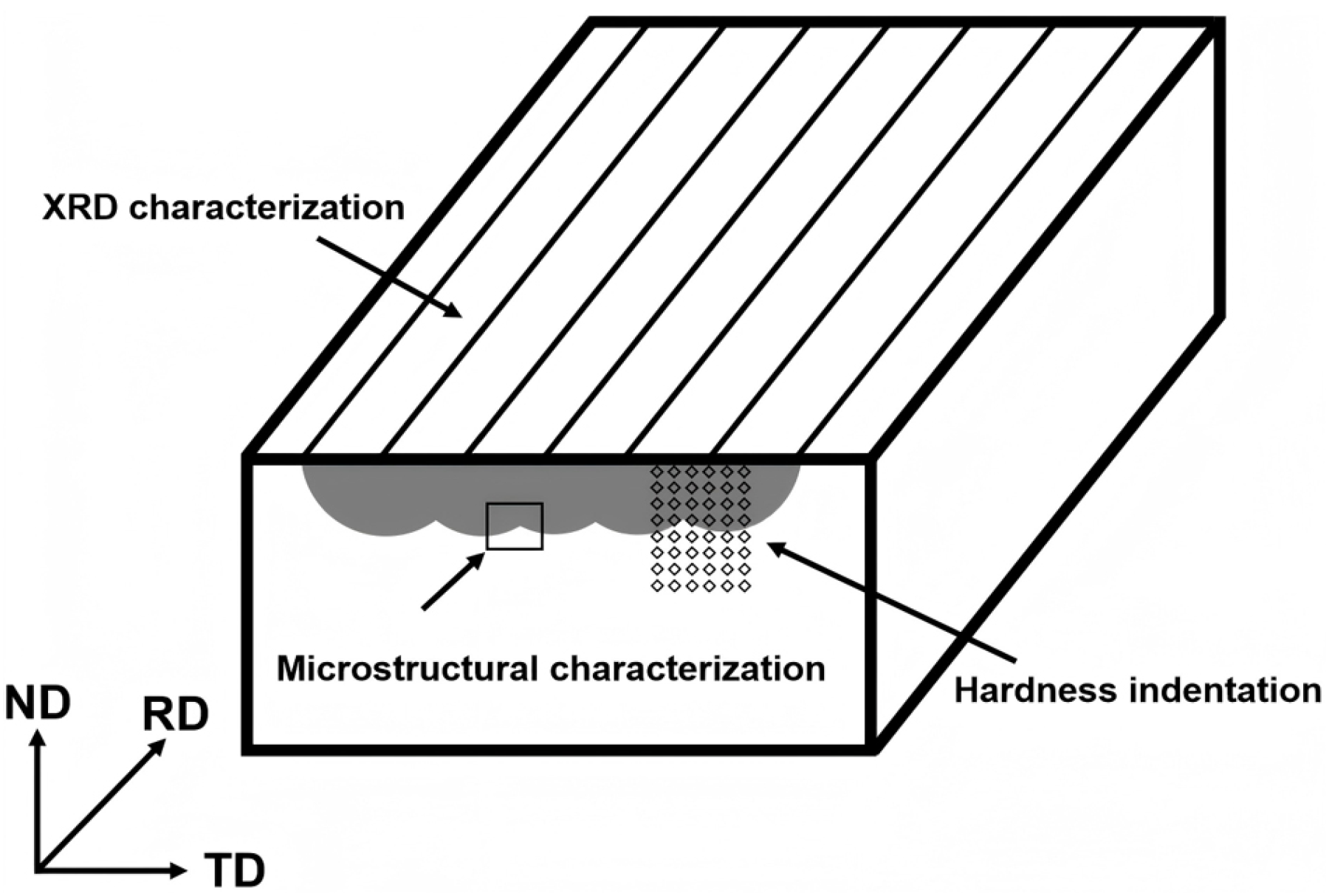

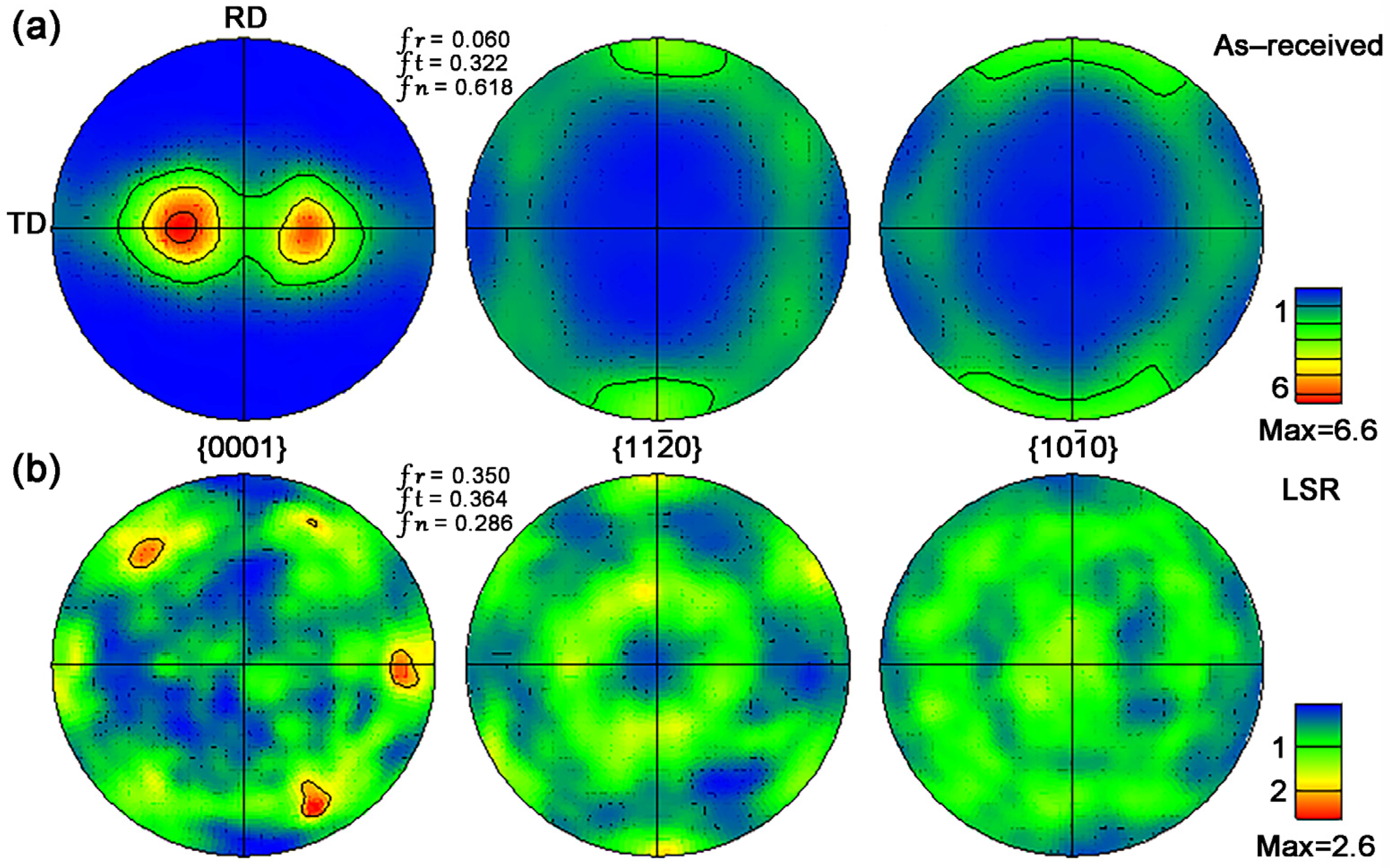

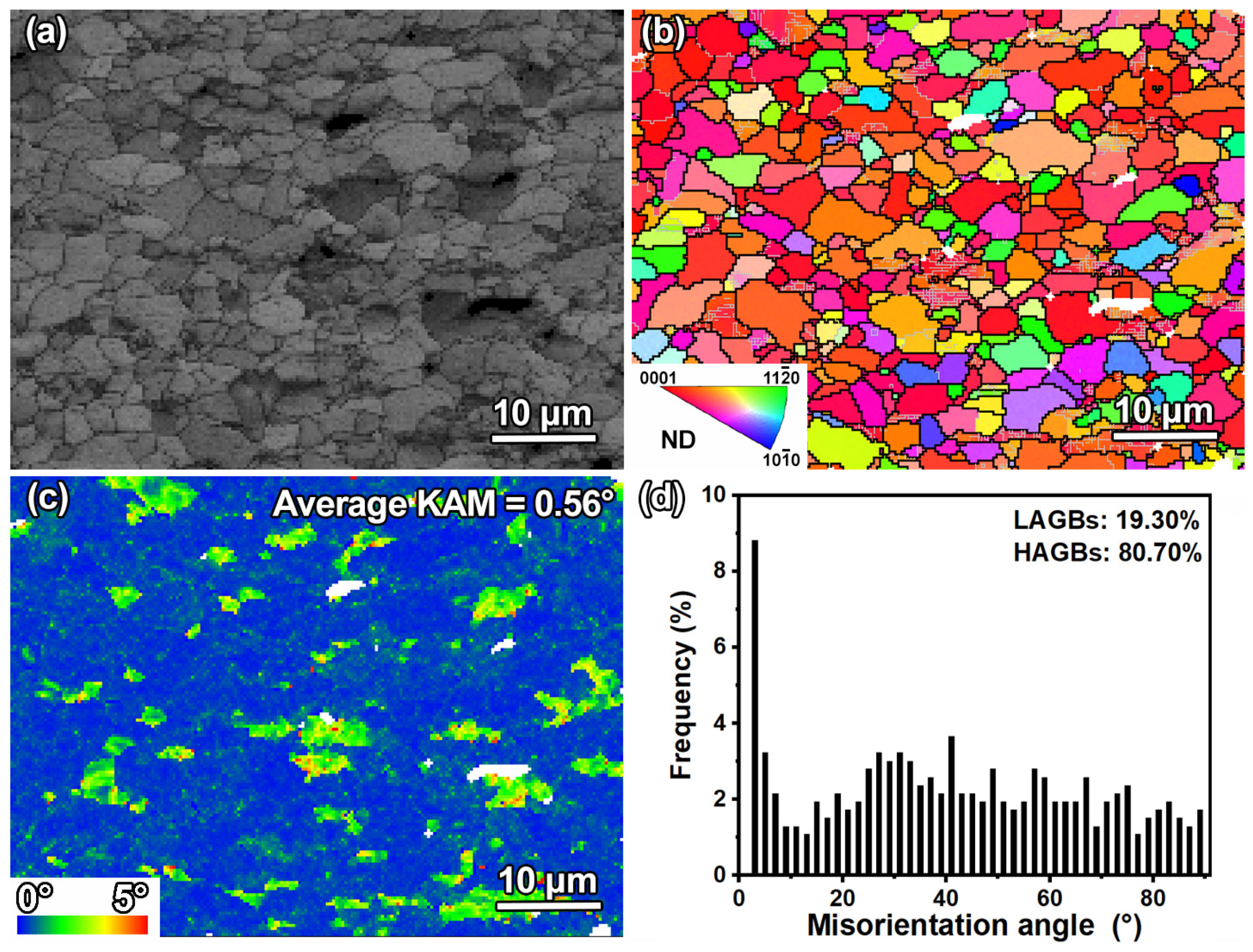
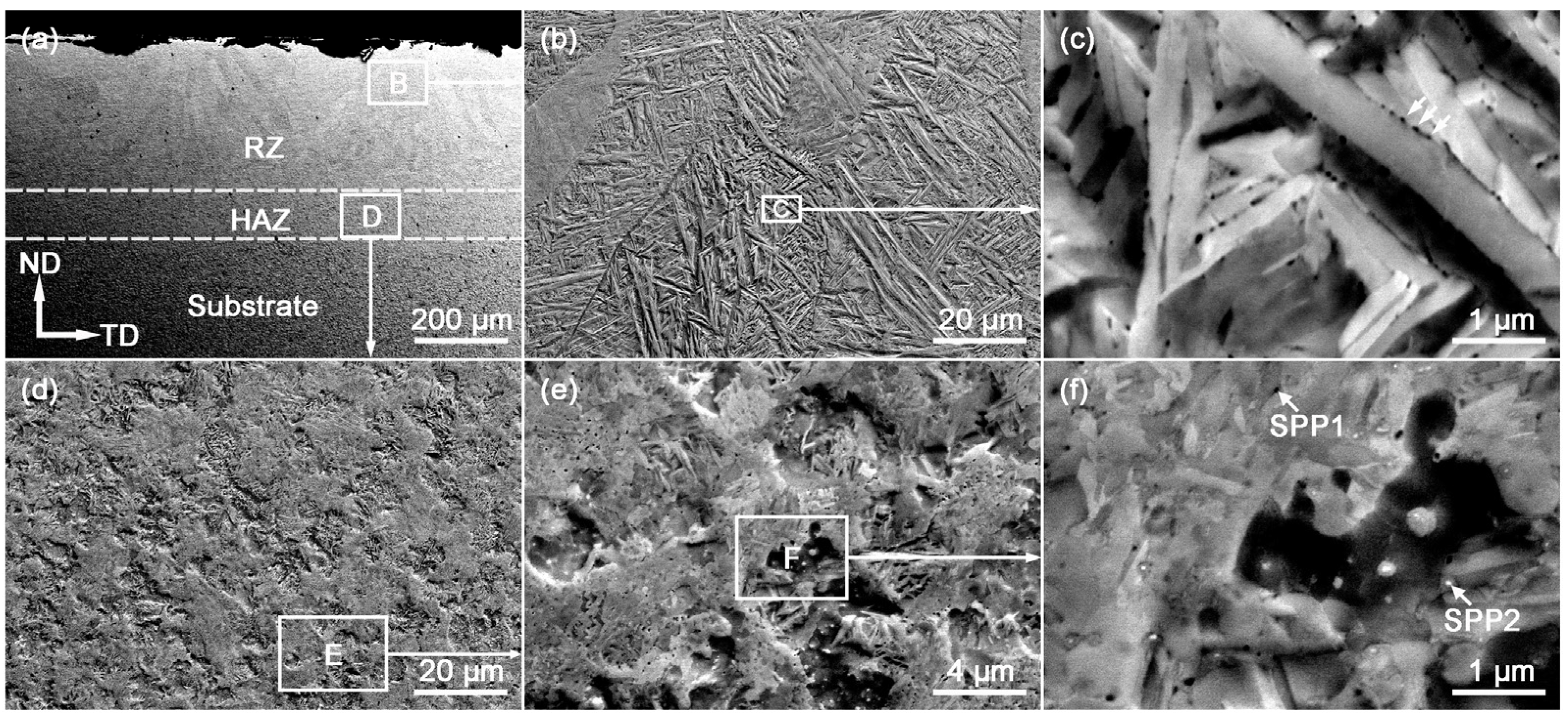
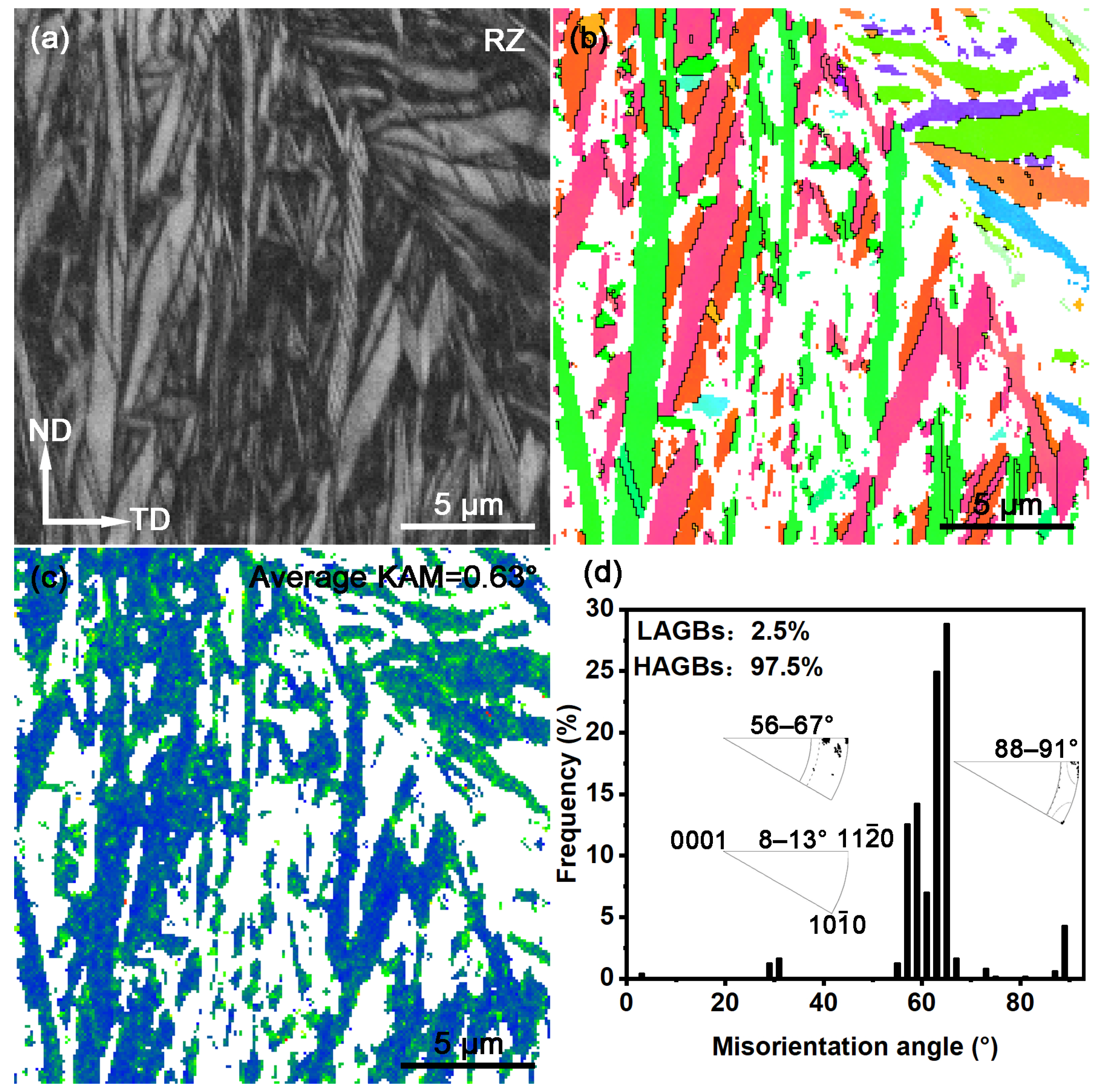

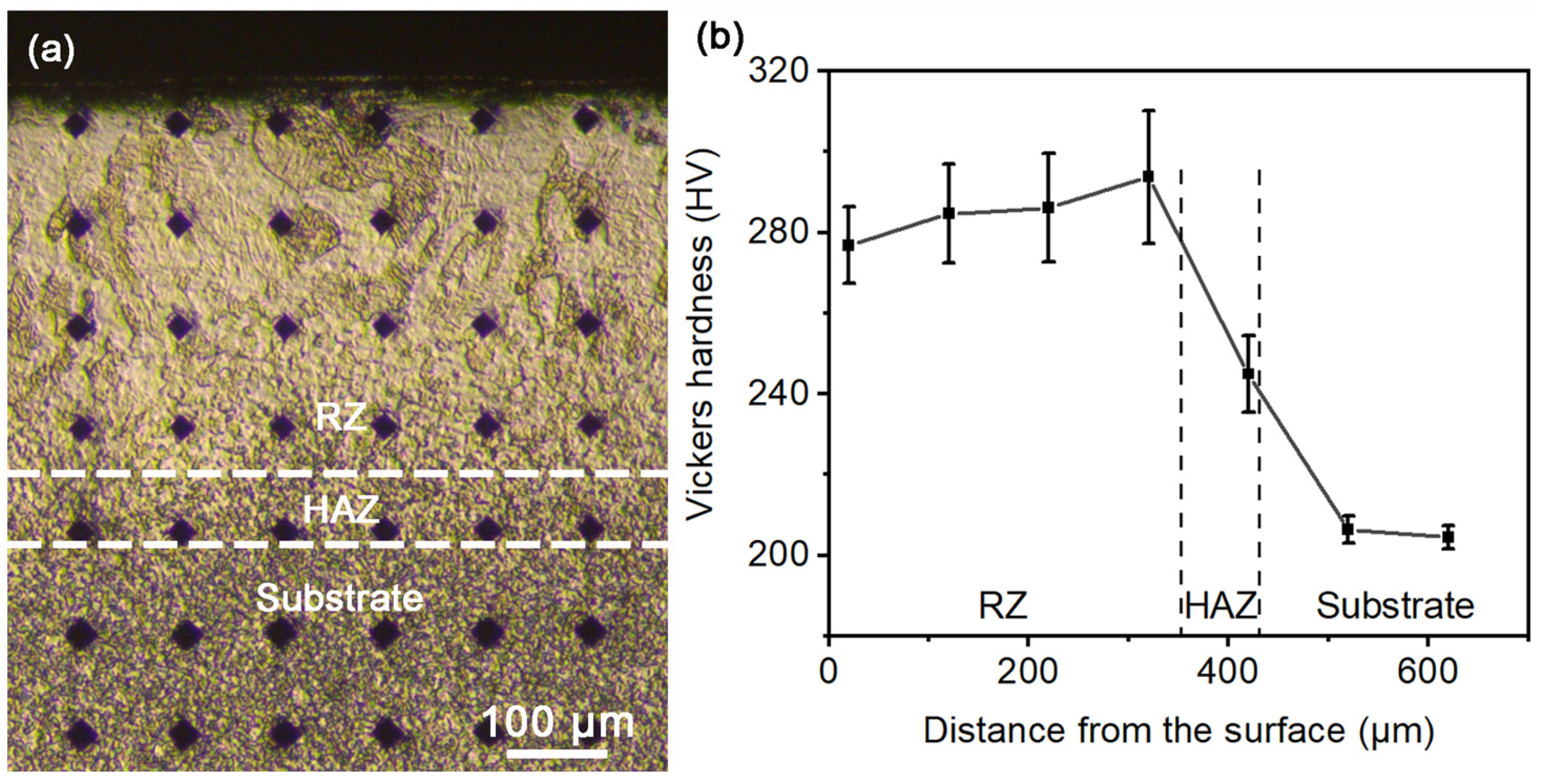
| Element | Nb | Sn | Fe | O | Zr |
|---|---|---|---|---|---|
| Content | 1.0 | 1.0 | 0.3 | 0.12 | Bal. |
| Power (W) | Peak Power (kW) | Laser Fluence (J·mm−2) | Frequency (Hz) | Pulse Width (ms) | Defocus Distance (mm) | Scanning Speed (mm·s−1) | Laser Spot Diameter (mm) |
|---|---|---|---|---|---|---|---|
| 50 | 0.5 | 1.25 | 20 | 5 | +2 | 8 | 1 |
Disclaimer/Publisher’s Note: The statements, opinions and data contained in all publications are solely those of the individual author(s) and contributor(s) and not of MDPI and/or the editor(s). MDPI and/or the editor(s) disclaim responsibility for any injury to people or property resulting from any ideas, methods, instructions or products referred to in the content. |
© 2025 by the authors. Licensee MDPI, Basel, Switzerland. This article is an open access article distributed under the terms and conditions of the Creative Commons Attribution (CC BY) license (https://creativecommons.org/licenses/by/4.0/).
Share and Cite
Ning, Z.; Zhang, F.; Wu, L.; Zhang, W.; Yang, J.; Zhao, X.; Chai, L. Surface Hardening of Zr-1.0Sn-1.0Nb-0.3Fe Alloy Induced by Laser Surface Remelting. Materials 2025, 18, 3948. https://doi.org/10.3390/ma18173948
Ning Z, Zhang F, Wu L, Zhang W, Yang J, Zhao X, Chai L. Surface Hardening of Zr-1.0Sn-1.0Nb-0.3Fe Alloy Induced by Laser Surface Remelting. Materials. 2025; 18(17):3948. https://doi.org/10.3390/ma18173948
Chicago/Turabian StyleNing, Zhien, Fangli Zhang, Lu Wu, Wei Zhang, Jijun Yang, Xiaotong Zhao, and Linjiang Chai. 2025. "Surface Hardening of Zr-1.0Sn-1.0Nb-0.3Fe Alloy Induced by Laser Surface Remelting" Materials 18, no. 17: 3948. https://doi.org/10.3390/ma18173948
APA StyleNing, Z., Zhang, F., Wu, L., Zhang, W., Yang, J., Zhao, X., & Chai, L. (2025). Surface Hardening of Zr-1.0Sn-1.0Nb-0.3Fe Alloy Induced by Laser Surface Remelting. Materials, 18(17), 3948. https://doi.org/10.3390/ma18173948







